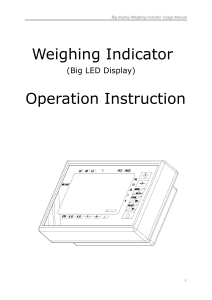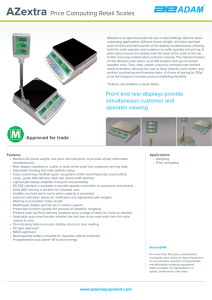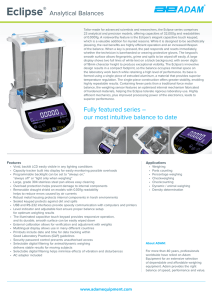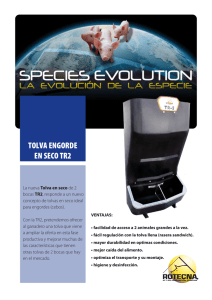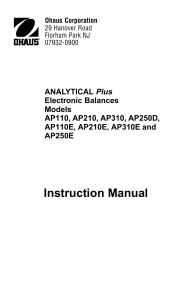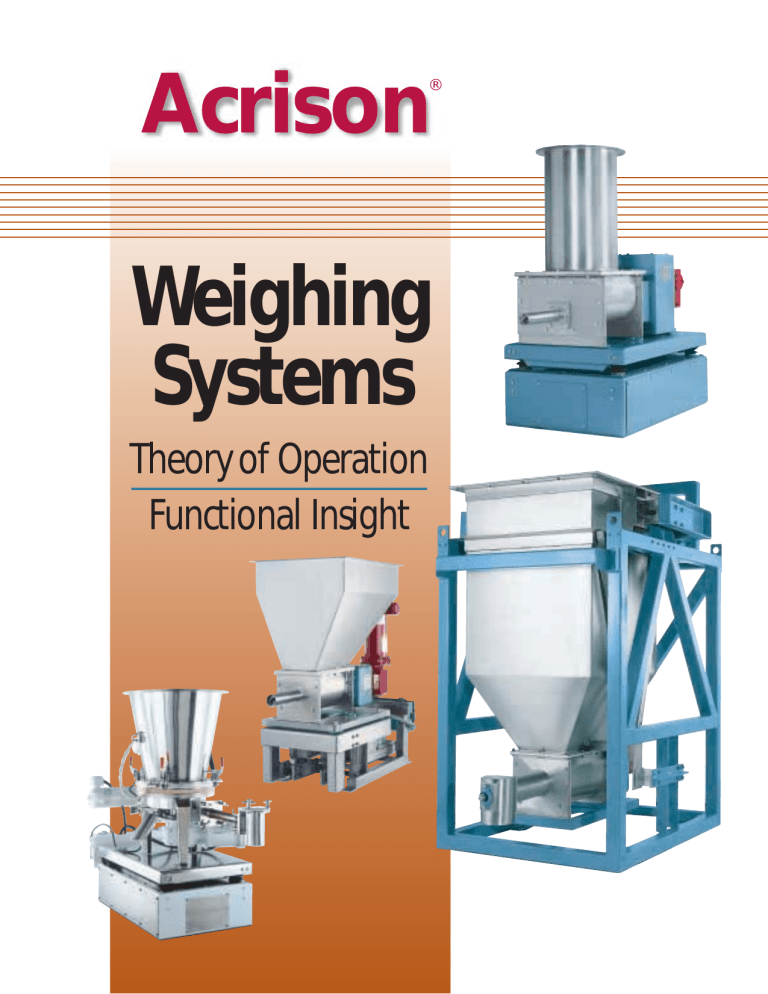
Acrison ® Weighing Systems Theory of Operation Functional Insight Acrison’s exclusive, non-load cell, high performance, Rugged-Duty Weighing Systems – Virtually Maintenance Free – Theory of Operation and Functional Insight Proven to be the most durable, reliable and trouble-free, Acrison’s various model weighing systems have admirably demonstrated their overall viability and operational integrity in thousands of installations, worldwide. Since 1970, these precision, high resolution, non-load cell weighing mechanisms have provided users with unmatched performance, unequaled dependability and by far, the lowest operating/maintenance costs in the industry. And unlike most weigh feeder scale mechanisms, the various weighing mechanisms utilized with Acrison weigh feeders have been specifically designed for such usage. As weight is added or subtracted from the weigh platform of Acrison “Platform” type weighing systems, or the hopper or tank of Acrison “Overhead” type weighing systems, the flexures that connect the various components of the lever network together rotate (or pivot) radially, in the range of 1 to 3 degrees about their central axis, thereby allowing the lever network (scale) to “move” in a direct and perfectly linear relationship to that weight. Movement of the lever network is frictionless and instantaneous as weight is applied to or removed from it. This movement is then precisely measured by Acrison’s Ratiometric Digital Weight Resolver, converting this motion into a highly accurate signal directly proportional to weight, in the form of a count ranging from 0 to 1,048,576 (or 20 bits). With this extremely high degree of weight sensing ability, even the smallest increment of movement of the lever network produces a change in signal easily sensed by the Ratiometric System. Movement of the lever network, at the point where this motion is physically sensed by the Ratiometric Weight Resolver Sensing Element, typically ranges between 100 and 180 thousandths of an inch. However, due to the mechanical ratio of the overall lever network, the weigh platform of “Platform” type scales, or the hopper or tank of “Overhead” type scales, only moves a maximum of 17 to 30 thousandths of an inch. This amount of displacement inherently provides an extremely stable weight signal, while significantly enhancing the scale’s immunity to external influences which generally tend to affect the conventional variety of load cell type weighing systems. Also, because of this amount of movement, hydraulic damping 2 means (dashpot) additionally and effectively assist Acrison weighing systems in their ability to tolerate common in-plant vibrations without the need for integration or manipulation of the weight signal, which usually adversely affects response of a weigh feeder. The specific or selected amount of movement, relative to a given scale’s maximum capacity, is determined by the size (radial torque and load specifications) of its flexures. In addition, all Acrison weighing systems are completely counterbalanced to offset the entire weight of the equipment mounted on it, thus ensuring the best possible degree of weight sensing precision by weighing only the net weight of the product and not the weight of the machinery as well. The flexures, designed and manufactured by Acrison, are heavy-duty in construction, fabricated of alloy stainless steel and not subject to wear or functional deterioration with age. They are also one piece in construction, not adjustable and extremely durable. In differing from the common variety of leaf type flexures utilized in most commercially available weighing systems (scales), Acrison flexures provide totally rigid pivotal attachments for the lever network both in the vertical and horizontal planes. Their proven ruggedness, linearity, repeatability, stability and life expectancy are unsurpassed. Regardless of model size and capacity rating, all Acrison weighing systems are user friendly and virtually maintenance-free; longevity is inherent in their design. These patented mechanisms have been designed to operate over an ambient temperature range of –10 to 140 degrees Fahrenheit without any operational variation. Factory (scale) calibration is accurate, complete and permanent, eliminating the need for any field adjustment whatsoever. In fact, provisions for adjustment are neither provided, nor do any exist. Calibration (or test) weights are not required or furnished. As an indication of Acrison’s confidence level in this equipment, the entire weighing mechanism of any Acrison weigh feeder, including its Ratiometric Digital Weight Sensor, is guaranteed for five years from date of shipment. Copyright 2002 – Acrison, Inc. – all rights reserved. Acrison’s “ Split-Beam” Platform Weighing System ® with Acrison’s Ratiometric Digital Weight Resolver Supply Hopper Weigh Platform Feeding Mechanism (Auger type shown) • • • • Model 402 Lever Beam (right) Lever Beam (left) • • Ratiometric Digital Weight Resolver • “Split Beam” Platform Weighing System (Model 402-105Z) Linkage Arm(s) Dashpot Main Support Structure of the Feeder ILLUSTRATION DEPICTS A “ WEIGHT-LOSS” DRY SOLIDS FEEDER NOTE: For liquid feeders, the dry solids supply hopper is replaced with a tank and the dry solids metering mechanism is replaced with a pump. Acrison weigh feeder models bearing the prefixes 402, 402X, 404, 404X, 404Z, 404BZ, 405, 406 and 260 utilize a “Platform” type Weighing System designed with a “Split-Beam” lever weighing network. With this configuration, the physical weighing mechanism is located beneath the equipment being weighed; the metering mechanism of a dry solids unit, or the tank of a liquid unit, mounts onto the “platform” of the weighing network (except for the Model 260). This particular weighing system, designed and manufactured by Acrison, is produced in a number of different sizes. And depending on the size, the lever weighing network utilizes either ten or twelve frictionless flexures for all pivotal connections. Please reference the illustrations. ■ Primary Support Flexures ■ Weigh Platform Support Flexures ■ Linkage Flexures ■ Counterbalance Weight These four flexures attach both the right and left lever beam assemblies to the main support structure of the feeder. These four flexures, one in each corner of the lever network, attach the weigh platform (upon which the equipment is mounted) to the lever network. These flexures link the right and left lever beams together by means of one or two linkage arms. A linkage arm utilizes two flexures, and the size of the weighing system determines the number of linkage arms. This is the weight added to the lever network to offset the total weight of the equipment mounted on the weigh platform. 3 Acrison’s Overhead Weighing System ® with Acrison’s Ratiometric Digital Weight Resolver Main Support Structure of the Feeder Primary Lever Beam • • Ratiometric Digital Weight Resolver Supply Hopper • • • Dashpot Feeding Mechanism (Auger type shown) Model 403 “Overhead” Weighing System (Model 403-BDF-2) Linkage Arm(s) ILLUSTRATION DEPICTS A “ WEIGHT-LOSS” DRY SOLIDS FEEDER NOTE: For liquid feeders, the dry solids supply hopper is replaced with a tank and the dry solids metering mechanism is replaced with a pump. Acrison weigh feeders and weighing equipment bearing the prefixes 270 and 403 utilize an “Overhead” type Weighing System designed with a modified parallelogram lever weighing network. With this configuration, the physical weighing mechanism is located above the equipment, with the metering mechanism of a dry solids unit, or the tank of a liquid unit, physically attached to, and an integral part of, the overall weighing system. This particular weighing system, designed and manufactural by Acrison, is produced in a number of different sizes. And depending on the size, the lever weighing network utilizes either six or eight frictionless flexures for all pivotal connections. Please reference the illustrations. 4 ■ Primary Support Flexures ■ Secondary Support Flexures ■ Linkage Flexures ■ Counterbalance Weight These two flexures attach the primary lever beam to the main support structure of the feeder. These two flexures attach the actual hopper or tank to the primary lever beam. These flexures secure the lower portion of the lever network to the main support structure of the feeder by means of one or two linkage arms, completing the modified parallelogram type lever weighing system. A linkage arm utilizes one or two flexures, and the size of the weighing system determines the number of linkage arms. This is the weight added to the lever network to offset the total weight of the equipment mounted onto the weighing system. Acrison’s “ Single-Beam” Platform Weighing System ® with Acrison’s Ratiometric Digital Weight Resolver Primary Support Flexures Supply Hopper Ratiometric Digital Weight Resolver Feeding Mechanism (Auger type shown) Dashpot • • • • • • • • Main Support Structure of the Feeder Secondary Support Flexures Primary Lever Beam Linkage Flexures • Model 407 “Single Beam” Platform Weighing System (Model 407-101) Linkage Arm(s) ILLUSTRATION DEPICTS A “ WEIGHT-LOSS” DRY SOLIDS FEEDER NOTE: For liquid feeders, the dry solids supply hopper is replaced with a tank and the dry solids metering mechanism is replaced with a pump. Acrison weigh feeder models bearing the prefixes 203, 210 and 407 utilize a “Platform” type Weighing System designed with a “Single Beam” lever weighing network. With this configuration, the physical weighing mechanism is located beneath the equipment being weighed; the metering (or conveying) mechanism of a dry solids unit, or the tank of a liquid unit, mounts onto the “platform” of the weighing network. This particular weighing system, designed and manufactured by Acrison, utilizes either six or eight frictionless flexures for all pivotal connections, and is produced in several different sizes. Please reference the illustrations. ■ Primary Support Flexures ■ Weigh Platform Support Flexures ■ Linkage Flexures ■ Counterbalance Weight These two flexures attach the primary lever beam to the main support structure of the feeder. These two flexures attach the weigh platform to the primary lever beam. These flexures secure the lower portion of the weighing network to the main support of the feeder by means of one or two linkage arms (depending upon the model and size of the weighing network), completing the modified parallelogram type lever system. A linkage arm utilizes two flexures. This is the weight added to the lever network to offset the total weight of the equipment mounted on the weigh platform. 5 Ratiometric® Digital Weight Resolver System Lever Mechanism of Weighing System 0.180 inches Maximum Movement Induction Element (Secured to Main Support Structure) of the Feeder 115-230/1/50-60 Input Lever Mechanism Power Supply Non-Contacting "Coupling" Element (Resolver) Flexure (Typ.) Main Support Structure of the Feeder Resolver Excitation Ratiometric Computational Module Resolver Output Output (Weight) Signal to Controller… a 20 Binary Bit Data Stream representing a count from 0 to 1,048,576 (unamplified). In 1977, Acrison introduced the Ratiometric Digital Weight Resolver Weight Sensing System as an integral part of its various weighing systems. With that introduction, Acrison provided industry with weigh feeders employing the first use of synchro-resolver technology for ultra-high resolution weight sensing in a system that is not only extremely precise, but also, highly dependable and well-suited for tough industrial usage. And, regardless of the model, size or capacity of the weighing system, the Ratiometric System is always identical. This totally adjustment-free system consists of a sensor and computational module, which together, generate a remarkable twenty binary bits of pure unamplified digital data for processing by Acrison’s various multiprocessor weigh feeder controllers. The Ratiometric Digital Weight Resolver is an incredibly precise, industrial quality displacement sensor, which is today, still the most precise measurement technology available. As weight is added or subtracted from an Acrison weighing system (scale), its lever mechanism “moves” in a direct and perfectly linear relationship to that weight. This movement is then precisely and instantaneously measured by the Ratiometric System, converting this motion into a highly accurate signal directly proportional to weight, in the form of a count ranging from 0 to 1,048,576. The computational module of Acrison’s Ratiometric Digital Weight Resolver Weight Sensing System utilizes state-of-the-art electronic and software techniques, including the use of military grade components…the same basic high technology employed in the most advanced military guidance systems. Techniques such as high speed sampling, digital filtering and serial transmission of data ensure that optimum weigh feeder performance is reliably achieved and maintained. Referring to the above illustration, only the “coupling element” of the weight sensor is physically attached to the weighing (lever) network, passing through the center of the “induction element” without any contact whatsoever. The induction element is mounted to the main structure of the weigh feeder. As weight is applied to, or removed from the scale, the coupling element moves within the induction element. This movement, at the point where displace6 ment is physically sensed, is typically 180 thousandths of an inch maximum… an ideal match for a sensor of this type, providing unequalled signal-to-noise ratios. To a user, this means that typical in-plant vibration is far less a problem for Acrison weigh feeders than for feeders utilizing weight sensors having very small movement, and virtually eliminates the need for heavy integration of the weight signal (which adversely affects weigh feeder response.) Unlike other weight sensors in weigh feeder use, Acrison’s Ratiometric Digital Weight Resolver Weight Sensing System is based upon the measurement of the ratio of two signals, not their absolute values. This technique allows it to: 1) operate totally unaffected by variations in its power supply up to as much as ± 30 percent; 2) operate over a temperature range of –10 to 140 degrees Fahrenheit without any noticeable change in output; 3) provide linearity to within 0.05 percent (repeatable to 0.005 percent), and 4) operate with insensitivity to a wide range of electrical “noise.” Further, the Ratiometric System does not require any sort of linearization, temperature compensation or calibration, and it is totally adjustment-free. The unique design of Acrison’s Ratiometric Weight Sensing System also ensures that it will be totally unaffected by any amount of shock or overload that the weighing system may experience, particularly important in the typically adverse industrial operating environments. Its non-contacting nature is also an extremely significant factor with respect to weight-loss type weigh feeder operation, specifically, the functional requirement of a weight-loss feeder to be periodically and rapidly refilled, which often produces an “impact” upon the weighing system, particularly, the larger units. Acrison’s Ratiometric Digital Weight Resolver Weight Sensing System is also FM Approved and Listed for operation in hazardous environments…Classes I, II and III; Divisions 1 and 2; Groups C, D, E, F and G. It also complies with European hazardous area classifications EExia IIBT4 and EExd[ia] IIBT6. Acrison Weighing Systems • Key advantages • Comparative facts First of all, it is important to recognize that all of Acrison’s various weighing mechanisms are “scales” independent of the weight sensor. They have been specifically designed for industrial weighing applications, and in particular, for “weight-loss” weigh feeding, whether continuous or batch. Because an Acrison weighing mechanism is a precision “scale,” movement of the lever network is perfectly linear to that weight which is added to the scale, or subtracted from it. Scale linearity and repeatability are extremely accurate; hysteresis is virtually non-existent and the weighing mechanism responds identically over its designed operating temperature range. Scale response is instantaneous, ultra-precise and uncommonly stable. Basically, all Acrison weighing (or scale) systems are designed for a maximum movement of 180 thousandths of an inch at the point where movement is physically sensed by the Weight Resolver, regardless of the scale’s capacity. The weighing mechanism is a lever network specifically configured so that the greatest amount of movement occurs where the Weight Resolver is located, greatly optimizing overall weight sensing performance and resolution. To provide an indication of the precision of this weighing system, please note that for 180 thousandths of an inch of movement, 1,048,576 counts are provided by the Ratiometric Weight Sensing System.This means, that for every one thousandth of an inch of movement, 5825 counts are generated, or for each one ten thousandths of an inch, 528 counts are produced, and for each one-one hundred thousandths of an inch, 58 counts are produced. Today, many thousands of these remarkably accurate weighing mechanisms operate in every corner of the world, including many of the very original units produced in the early 1970’s, strongly attesting to their long-term viability. • Unlike the common variety of delicate, maintenance-prone leaf type flexures used in various type weighing or scale systems, Acrison flexures are rigid in both the vertical and horizontal planes, thereby eliminating a major source of difficulty typical of delicate leaf type flexure weighing systems. Also, Acrison flexures do not wear, fatigue, vary with age, or change with temperature (within the designed temperature range of the weighing system). They are constructed of stainless steel for both corrosion resistance and longevity, and their uncommon ruggedness is a well known and respected characteristic. weight of product is weighed.This is only possible with a lever type weighing network specifically designed with counterbalancing provisions. With basic multiple load cell type weighing systems, this is not possible and therefore, the weight of all of the equipment mounted on the load cells must be subtracted from their total capacity, leaving only whatever capacity remains for use by the weigh feeder. This generally represents a major reduction of weight sensing resolution, sensitivity and flexibility. • As a general fact, load cells are temperamental and tend to drift. They also require periodic calibration and are easily damaged, especially in tough environments. And when a weighing system utilizes more than one load cell, the potential for increased maintenance escalates proportionately. Load cells have full load displacement characteristics that range from one-half to 3 or 4 thousandths of an inch total, and thus, are very susceptible to in-plant vibrations and/or the effects of temperature variations that typically cause their mounting structure to expand and contract, often severely affecting their ability to weigh accurately. These are well known difficulties normally associated with load cell type weighing systems. [For example, structural expansion or contraction caused by temperature variations, or movement caused by inplant vibration, can easily assume a major portion, or possibly exceed, the maximum deflection (or load) rating of a load cell.] With the various Acrison weighing systems, compensation for mechanical contingencies associated with temperature variations have been completely addressed within the structural/lever system design. Thus, in comparison and by virtue of their functional displacement alone, Acrison weighing systems are 45 to 360 times less vulnerable to in-plant vibrations than the various types of conventional load cell weighing systems, just from a mechanical displacement viewpoint alone, or what is usually termed as the “signal to noise ratio.” Because of this, electronic “signal conditioning,” normally encompassed within load cell type weighing systems (that usually tends to slow-down response and/or distort weight sensing accuracy), is not necessary or provided with Acrison weighing systems. • Simply put, based on the mechanical design of the various Acrison • Many of the conventional weigh feeder or batch/dump type weighing systems use load cell based designs, with the load cell (or cells) representing either the entire weighing system (i.e., equipment completely mounted on 3 or 4 load cells, or a single load cell weight sensing arrangement as part of a weighing system). In either case, the load cell is the weight sensing device, providing an output signal directly proportional to the amount of applied load. Without the load cell (or load cells) in such weighing systems, a “scale” does not exist. weighing systems, their basic inherent ability to cope with typical inplant environmental contingencies represents a significant and distinct advantage over delicate load cell type weighing systems. Moreover, unlike a load cell weighing system, Acrison’s Ratiometric Digital Weight Sensing System cannot be damaged by any magnitude of overload or shock that the weighing system may experience, because the weight sensor does not physically make contact with the weighing mechanism; a very important and major advantage. Acrison weighing systems are also completely calibration and adjustment-free and do not include any means or provisions for adjustment. In addition, and aside from their extreme ruggedness, durability and dependability — which are widely recognized throughout the industry — their remarkable trait for “permanence of accuracy and calibration,” has always been a most envious accomplishment. • Acrison weighing systems are “counterbalanced” which means the • Acrison’s 5 year unconditional warranty on the entire weighing system weight of the entire metering mechanism and its supply hopper (or tank) are completely “tared-off ” or “balanced-out”, so that only the net (of any Acrison weigh feeder) is the only warranty of its type in the industry. 7 Discover the difference! We cordially invite you to witness a test in Acrison’s state-of-the-art Customer Demonstration Facilities handling your actual product(s) with the specific equipment we recommend for the application. Usually, there is no cost or obligation for this service. Discover the difference in technology, quality and performance of Acrison equipment. Acrison products… • • • • • • • • • • • • • • • • • • • • • • • • • • • • • Models 101 and 130 Volumetric Feeder Series Models V101 and V130 Volumetric Feeders Model 1015 Volumetric Feeder Series Model 105 Volumetric Feeder Series Model W105 Volumetric Feeder Series Model 120 Volumetric Feeder Model 140 Volumetric Feeder Series Model 170 Volumetric Feeder Series Model 203 and 210 Series of Weigh Belt Feeders Model 203B Series of Weigh Auger Feeders Model 260 Series of Weigh Belt Feeders Model 270 Series of In-Line Weigh Feeders Models 350 and 301 Continuous Blenders and Blending Systems Model 402 Series of "Weight-Loss-Differential" Weigh Feeders Model 403 Series of "Weight-Loss-Differential" Weigh Feeders Model 403 (D) Batch/Dump "Weight-Loss-Differential" Batch Weigh Feeders Model 404 Series of "Weight-Loss-Differential" Weigh Feeders Model 404BZ (BU) Bulk Bag Unloader Batch Weigher/Feeder Model A405 Series "Weight-Loss-Differential" Weigh Feeders Model 406 Series "Weight-Loss-Differential" Weigh Feeders Model 407 Series of "Weight-Loss-Differential" Weigh Feeders Multiple Auger Bin Dischargers and Multiple Auger Bin Discharger Hoppering Systems Multiple Auger Bin Discharger Feeders Vibratory Bin Dischargers Model 500 Series of Liquid and Dry Polyelectrolyte Preparation Systems Water and Waste Water Treatment Systems Volumetric and Gravimetric Feeder Controllers and Control Systems Accessory Equipment for Acrison Products Systems Engineering “ Visibly Different… Measurably Better ” Acrison ® 20 Empire Blvd. Moonachie, NJ 07074 201-440-8300 • Fax: 201-440-4939 Email: informail@acrison.com Website: www.acrison.com ® 300-0058/ C/6-02/ 7008 Domestic and Foreign Patents issued and pending. Acrison is a Registered Trademark of Acrison Inc., Moonachie, New Jersey

